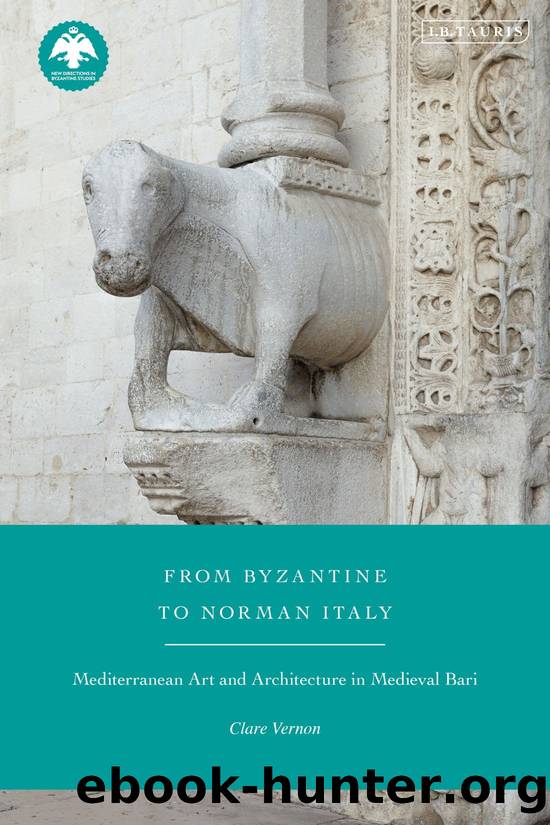From Byzantine to Norman Italy by Clare Vernon;

Author:Clare Vernon;
Language: eng
Format: epub
ISBN: 9780755635757
Publisher: Bloomsbury UK
Published: 2022-11-09T00:00:00+00:00
Conclusion to Part 2
In the roughly thirty years in which San Nicola was built and decorated, Bari went through a lot of changes and so did the church. Three phases can be identified: 1087â95, the immediate post-Byzantine phase; 1095â1105, in which the relationship between Elias and Urban II meant that the ideology of the first crusade was reflected in the building; and 1105â23, after Eliasâs death when the decoration was focused on the pavement in the upper sanctuary. In the first, post-Byzantine phase, the new church was a way for the citizens of Bari to assert their identity and power, ushering in a new era that was consciously post-Byzantine. At the same time, the citizens used the church as a way to assert their independence within the new Norman duchy, carving out a distinctive artistic and religious climate in Bari. As the building work progressed, that climate changed. The departure of southern Italians on crusade, the arrival of northern European crusaders passing through Bari, the influx of pilgrims, the visits of the Greek and Latin clergy for the Council of Bari in 1098, the continued relationship with Urban II and the news of crusader victories accompanied by the captured tent of Kerbogha of Mosul all shaped the church as it was being built. In this phase, the first crusade and the reform agenda came to dominate the church. In the third phase, under Abbot Eustasius, the church was mostly finished and Eustasius was only left to decorate it (although that process was possibly well underway when Elias died). The extent of Eustasiusâs contribution is uncertain, but at the very least he wrote a learned inscription on the sanctuary steps that reveals him to have been perhaps interested in reform issues.
This detailed examination of the construction of San Nicola has revealed that Bari was a major centre of artistic production that was distinctive and developed mostly independently of other centres of artistic innovation such as Montecassino and Salerno (although in the early phase of construction, Salerno was influential). San Nicola quickly became a model for other churches in Apulia. By the middle of the twelfth century, the southern Adriatic coast and its hinterland were scattered with buildings inspired by San Nicola. Bari deserves recognition alongside Montecassino, Salerno and Palermo as a nexus of innovation in southern Italian art. Elias of Bari deserves recognition as a major patron, alongside Desiderius, Alfanus, George of Antioch and Roger II.
Download
This site does not store any files on its server. We only index and link to content provided by other sites. Please contact the content providers to delete copyright contents if any and email us, we'll remove relevant links or contents immediately.
| Belgium | France |
| Germany | Great Britain |
| Greenland | Italy |
| Netherlands | Romania |
| Scandinavia |
Room 212 by Kate Stewart(4741)
The Crown by Robert Lacey(4574)
Endurance: Shackleton's Incredible Voyage by Alfred Lansing(4508)
The Iron Duke by The Iron Duke(4124)
The Rape of Nanking by Iris Chang(4024)
Killing England by Bill O'Reilly(3899)
Joan of Arc by Mary Gordon(3786)
Say Nothing by Patrick Radden Keefe(3726)
I'll Give You the Sun by Jandy Nelson(3274)
Shadow of Night by Deborah Harkness(3177)
Hitler's Monsters by Eric Kurlander(3165)
Mary, Queen of Scots, and the Murder of Lord Darnley by Alison Weir(3069)
Blood and Sand by Alex Von Tunzelmann(3060)
Darkest Hour by Anthony McCarten(3019)
Margaret Thatcher: The Autobiography by Thatcher Margaret(2972)
Eleanor & Park by Rainbow Rowell(2944)
Red Famine: Stalin's War on Ukraine by Anne Applebaum(2816)
Book of Life by Deborah Harkness(2721)
The One Memory of Flora Banks by Emily Barr(2686)
